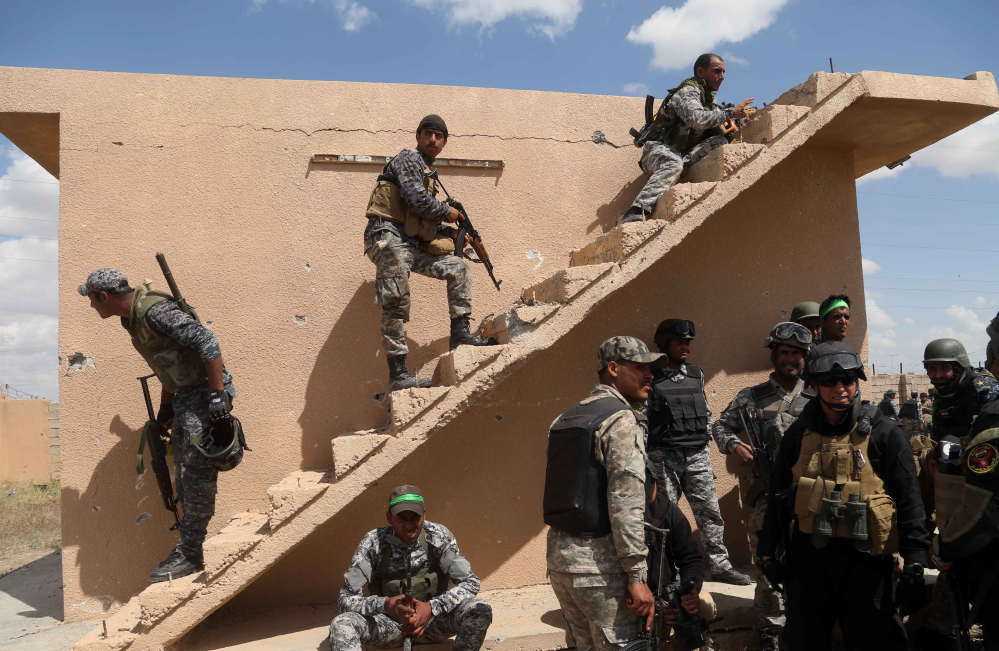BAGHDAD — Iraqi forces claimed to have seized the city of Tikrit from Islamic State militants on Tuesday after U.S.-led airstrikes cleared the way for ground operations, an advance that would mark the government’s most significant victory over the extremists since their summer blitz.
In a televised address, Prime Minister Haider al-Abadi announced that Tikrit had been liberated after security forces and “popular mobilization” units, a grouping of pro-government fighters that includes Iranian-backed Shiite militias, made rapid inroads into the city. However, military officials said some areas of the city were yet to be entered because roads and buildings were heavily rigged with explosives — raising the possibility that some militants remain.
The recapture of Tikrit, about 110 miles north of Baghdad, would constitute the first time that Iraqi security forces have wrested back a major population center from the militant group, boosting hopes for an offensive targeting the larger city of Mosul.
But it also highlighted the inability of Iraqi forces to advance without the support of precision airstrikes. The month-long battle to secure the city, which initially relied on Iranian advisers and left the United States out of the planning, had stalled until U.S.-led coalition strikes helped pave the way for a ground offensive.
Abadi said Iraqi and coalition forces had carried out “painful” airstrikes against the militants, enabling the final push by pro-government forces.
“Our heroic forces have entered the center of Tikrit and have raised the Iraqi flag over the building of the province,” he said, referring to a local government structure. “Now they are clearing the remaining edges of the province.”
The inclusion of Iranian-backed militias in the Iraqi government’s offensive, however, is likely to cause some consternation in Washington, where there were concerns about U.S. planes serving as a vanguard strike force for paramilitary groups accused of human rights abuses. Both the United States and the Shiite militias had balked at working together on the offensive, but they ended up doing so tacitly.
Iraqi military officials have said that the capture of Tikrit, which is about halfway between Baghdad and Mosul, the Islamic State’s power base in Iraq, is necessary before the launch of any operation to reclaim Mosul and the surrounding province of Nineveh.
Lt. Gen. Abdulwahab al-Saidi, an Iraqi counterterrorism commander leading the ground offensive, confirmed that Tikrit was essentially in government hands but noted also that security forces were grappling with the painstaking task of clearing roadside bombs and booby traps in some areas.
A Defense Ministry official who spoke on the condition of anonymity because of the sensitivity of the subject said Iraqi forces were yet to enter some areas of the city because of the risk of explosives. However, security forces no longer faced any sniper fire, he said.
A compound of palaces built by Saddam Hussein that had become an Islamic State headquarters had not been cleared of explosives as of Tuesday, but Saidi said no militants remained inside. He estimated that about a dozen insurgents were left in the city.
Saidi said coalition and Iraqi airstrikes had killed hundreds of militants, including some senior leaders, before ground troops entered the area.
The Shiite militias involved in the offensive announced Monday that they were rejoining the fight, after initially drawing back when the United States launched airstrikes.
Militia leaders refused to admit Tuesday that they were still working under American air cover. One coalition strike occurred overnight as the pro-government forces advanced, according to Col. Wayne Marotto, a spokesman for the coalition operation.
“When it was necessary, all of the popular mobilization [units] decided to participate for the benefit of the country,” said Karim al-Nouri, a spokesman for the forces and a military commander for the Badr Organization, one of Iraq’s most prominent Shiite militias.
Federal police and the popular mobilization forces played a major role in the offensive from the southern flank, officials said.
Naim al-Abboudi, a spokesman for the Shiite paramilitary group Asaib Ahl al-Haq, said his fighters were inside the city’s local government buildings.
About 500 Sunni tribesmen from the area also helped in the offensive, said Sheik Marwan al-Jabara, a spokesman for the provincial council in Salahuddin, where Tikrit is located.
Efforts were underway to recruit more fighters to assist in holding the city, he said. “We are expecting families to come back very soon and life to return to the city.”
But Tikrit first needs to be cleared of the explosives left by the retreating militants. Jabara estimated that about 10 percent of the city was out of bounds because of this danger. “Maybe there are still some Daesh [fighters] hiding,” he said, using the Arabic acronym for the Islamic State, which is also known as ISIS or ISIL.
Although the win in Tikrit buoyed the spirits of Iraq’s security forces, the battle for Mosul is expected to be far more complex. While Tikrit was largely empty of civilians, hundreds of thousands remain in Mosul, where Islamic State militants have imposed restrictions on residents to keep them from leaving.
“To liberate Mosul, it’s possible, but it will take a lot of time,” Saidi, the Iraqi commander, said. “There are a lot of civilians. It’s not like Tikrit.”
Copy the Story Link
Send questions/comments to the editors.



Success. Please wait for the page to reload. If the page does not reload within 5 seconds, please refresh the page.
Enter your email and password to access comments.
Hi, to comment on stories you must . This profile is in addition to your subscription and website login.
Already have a commenting profile? .
Invalid username/password.
Please check your email to confirm and complete your registration.
Only subscribers are eligible to post comments. Please subscribe or login first for digital access. Here’s why.
Use the form below to reset your password. When you've submitted your account email, we will send an email with a reset code.